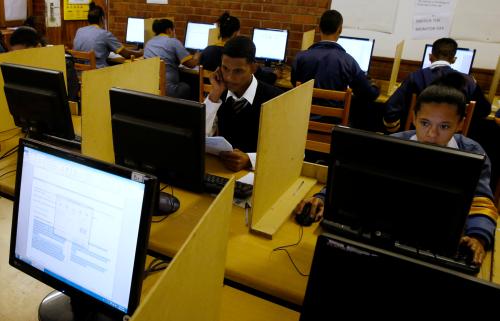The underappreciated but critically important E-Rate program faces a fork in the road in 2017. Created during the Clinton administration, E-Rate originally intended to make it easier for schools to purchase dial-up internet connections. However, the program languished for many years while internet and education technologies improved by leaps and bounds. In 2014, the Obama administration revamped the program by nearly doubling the available funding and incentivizing the adoption of 21st-century technologies. The funding mechanism and presumably better E-Rate results portend a positive year for the program, though political uncertainty under a new administration signals there may be some rough waters ahead.
Striving for better E-Rate results
This year could finally be the time when investments in E-Rate pay off in terms of clear, positive effects for students. Many policymakers are hopeful that ubiquitous and fast internet connections in schools will lead to improvements in student achievement, though the evidence to this point does not necessarily suggest that. Previous research has found that while E-Rate increased internet investments, the average treatment effect of E-Rate on student achievement is likely null or negative. However, there is evidence for a heterogeneous treatment effect where schools in low-income communities see significantly positive gains. This makes sense given that middle- and high-income communities already have reasonably fast internet connections, and all schools are eligible for E-Rate subsidies. The effect of the E-Rate intervention would likely be smaller in communities that would have had the financial flexibility to purchase internet access without the subsidy.
The Obama reforms made two major changes that we would expect to have delayed effects, making 2017 a potentially impactful year for the program. With Obama’s modernization of E-Rate in 2014 and the substantive changes to the program, E-Rate may be much more effective in its new form. Overall funding increased from $2.4 to $3.9 billion, and the reformed program now includes dedicated funding for Wi-Fi and no longer allows schools to use subsidies for antiquated technologies like pagers and fax machines. If lack of funding and use of antiquated internet technologies were major challenges to E-Rate’s efficacy, their removal in 2014 may yield positive results emerging now as districts are actively shifting funds to more effective uses.
The 2014 reforms also simplified the extremely burdensome and complex application process. Although the paperwork reduction seems like a superficial change, it could have an outsized effect. Prior to these reforms, the E-Rate application required hundreds of pages of paperwork each year. Applicants were required to apply for funds in the current funding year in addition to verifying details in applications for the previous two years. The GAO found that 23 percent of applications were declined “because applicants did not correctly carry out application procedures.” In theory, removing the paperwork barrier could lead to increased participation in districts serving low-income students that previously lacked the human resources to fill out the voluminous application.
The E-Rate funding mechanism
One feature that serves to shield E-Rate is the program’s funding mechanism. E-Rate does not receive funding from the standard congressional appropriations process. A 1996 law requires telecommunication companies to contribute to the Universal Services Fund, which in turn provides the funding for E-Rate and other programs. Overall, this arrangement is equivalent to a tax, but it’s insulated from the tumult of the congressional budgeting process.
The unique funding mechanism decreases the likelihood that E-Rate would attract negative attention from congressional Republicans. However, the new Republican leadership at the Federal Communications Commission (FCC)—which oversees E-Rate—could choose to cut spending. Returning E-Rate funding to pre-Obama reform levels, but keeping most of the modernization reforms, would be compatible with the position of new FCC Chairman Ajit Pai, a Republican. Pai has explained that his 2014 vote against the Obama E-Rate reforms was due to concerns about financial waste in the program rather than questioning the overall usefulness of the program.
Navigating the politics of school internet access
There are several reasons to expect bipartisan support for the E-Rate program moving forward. At the local level, all school districts are eligible for E-Rate funding. School districts in rural areas and those with more impoverished students receive larger subsidies. This funding scheme means that schools in every congressional district benefit from the program. The new administration has indicated it will focus on choice and standards when it comes to education policy. Furthermore, the E-Rate subsidy formula treats charter schools and public schools the same. Charter schools with new buildings or those in impoverished areas that typically have slow internet connections stand to benefit from increased E-Rate spending.
Nonetheless, recent events suggest that this program may be vulnerable to changes under the new administration. In early February, FCC Chairman Pai “revoked” a report that lauded the success of E-Rate. Many were concerned this action indicated that the FCC was reconsidering the Obama reforms. Pai has argued that he continues to support the program and explained that the report was scrapped because it was issued without the consideration of a majority of FCC commissioners. More recently, Republican Commissioner Michael O’Rielly has requested an investigation in potential sources of waste in E-Rate spending. These actions are puzzling because the Republican FCC leadership has aggressively pursued changes to other programs; if they were interested in pursuing a similar approach with E-Rate, it is unclear why they would obfuscate.
A major barrier to the potentially beneficial effects of internet-dependent innovations like personalized learning is lack of adequate bandwidth in the nation’s schools. The modernized E-Rate program could help to address that challenge. But, if E-Rate no longer enjoys the full support of the FCC, it is unclear whether the program will achieve its goals, at least as defined under the Obama administration. Though this issue may fly under the radar given the number of high-stakes policy decisions on the new administration’s docket, how the FCC decides to approach the E-Rate program moving forward may determine the program’s long-term success or failure.






Commentary
2017: E-Rate’s make or break year
March 9, 2017